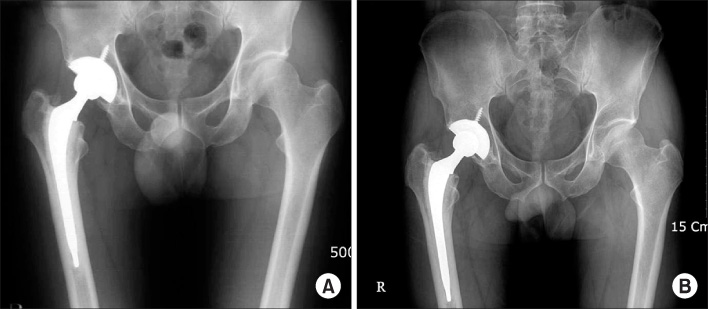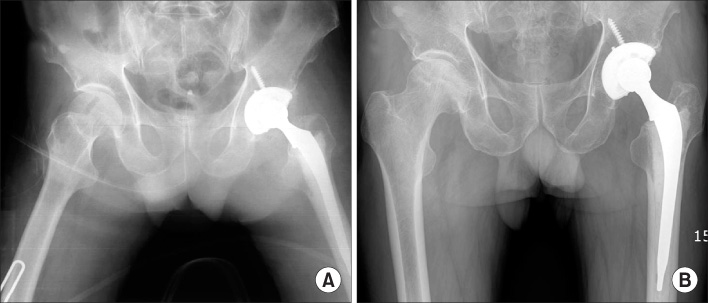J Korean Orthop Assoc.
2008 Feb;43(1):9-16. 10.4055/jkoa.2008.43.1.9.
2-5 Year Results of the Cemented Polished Versys Heritage(R) Femoral Stem
- Affiliations
-
- 1Department of Orthopaedic Surgery, Korean University Guro Hospital, Seoul, Korea. wonyong@kumc.or.kr
- KMID: 2106410
- DOI: http://doi.org/10.4055/jkoa.2008.43.1.9
Abstract
-
PURPOSE: Surface finishing of a cemented femoral stem is a subject of controversy even though contemporary cementing techniques have improved results. Versys Heritage femoral stem was used with a contemporary cementing technique to determine the outcome of using a polished surface.
MATERIALS AND METHODS
Between October 2000 and August 2003, 131 primary hybrid hip arthroplasty procedures were performed in 117 patients. The mean age at the time of the index arthroplasty was 52 years and 9 months (24-78 years). The average follow up period was 49 months (range, 24-71 months). All the hips were evaluated clinically by the Harris hip score and radiologically by the cement grade, osteolysis as well as stress shielding.
RESULTS
At the final follow up, the Harris hip score for all patients had improved from preoperative 59.1 (range, 17-91) to post operative 92.8 (range, 78-100). The cement grade was measured using Barrack's method. Of 131 hips, 75, 54 and 2 were grade A, grade B and grade C1 at the final follow up, respectively. None of the hips showed a C2 or D grade. There was no evidence of aseptic loosening or osteolysis on the femoral side during follow up. 45% of stems showed grade 1 and 2 stress shielding according to Engh's criteria.
CONCLUSION
In this study, the Polished Versys Heritage femoral stem(R) showed excellent results at the short to mid term follow up period. However, a longer-term follow-up study will be needed to clarify the implications of the femoral prosthesis surface finish or design.
Figure
Cited by 1 articles
-
Long-term Outcome of Polished Stems in Total Hip Arthroplasty
Jin-Young Park, Hong-Joon Han, Seok-Jong Baik, Suc-Hyun Kweon
Hip Pelvis. 2015;27(2):83-89. doi: 10.5371/hp.2015.27.2.83.
Reference
-
1. Barrack RL, Mulory RD Jr, Harris WH. Improved cementing techniques and femoral component loosening in young patients with hip arthroplasty. A 12-year radiographic review. J Bone Joint Surg Br. 1992. 74:385–389.
Article2. Beckenbaugh RD, Ilstrup DM. Total hip arthroplasty. J Bone Joint Surg Am. 1978. 60:306–313.
Article3. Collis DK, Mohler CG. Loosening rates and bone lysis with rough finished and polished stems. Clin Orthop Relat Res. 1988. 355:113–122.
Article4. Collis DK, Mohler CG. Comparison of clinical outcomes in total hip arthroplasty using rough and polished cemented stems with essentially the same geometry. J Bone Joint Surg Am. 2002. 84:586–592.
Article5. DeLee JG, Charnley J. Radiological demarcation of cemented sockets in total hip replacement. Clin Orthop Relat Res. 1976. 121:20–32.
Article6. Engh CA, Bobyn JD. The influence of stem size and extent of porous coating on femoral bone resorption after primary cementless hip arthroplasty. Clin Orthop Relat Res. 1988. 231:7–28.
Article7. Fowler JL, Gio GA, Lee AJ, Ling RS. Experience with the Exeter total hip replacement since 1970. Orthop Clin North Am. 1988. 19:25–37.8. Harris WH. Is it advantageous to strengthen the cement metal interface and use a collar for cemented components of total hip replacements? Clin Orthop Relat Res. 1992. 285:67–72.9. Harris WH. Long-term results of cemented femoral stems with roughened precoated surfaces. Clin Orthop Relat Res. 1998. 355:137–143.10. Harris WH, Maloney WJ. Hybrid total hip arthroplasty. Clin Orthop Relat Res. 1989. 249:21–29.
Article11. Harris WH, McGarthy JC Jr, O'Neill DA. Femoral component looseing using contemporary techniques of femoral cement fixation. J Bone Joint Surg Am. 1982. 64:1063–1067.12. Ito H, Matsuno T, Minami A. Pre-coated femoral components in hybrid total hip arthroplasty. J Bone Joint Surg Br. 2005. 8:306–309.
Article13. Lachiewicz PF, Messick P. Precoated femoral component in primary hybrid total hip arthroplasty: results at a mean 10-year follow-up. J Arthroplasty. 2003. 18:1–5.
Article14. Levy RN. The Precision hip experience. The effect of cement mantle geometry and a centralized rough surfaced stem on hip arthroplasty results at long term. Presented at the Harvard Hip Course. 1998. Boston, MA.15. Malchau H, Herberts P, Ahnfelt L. Prognosis of total hip replacement in Sweden. Follow-up of 92,675 operations performed 1978-1990. Acta Orthop Scand. 1993. 64:497–506.
Article16. Massoud SN, Hunter JB, Holdsworth BJ, Wallace WA, Juliusson R. Early femoral loosening in one design of cemented hip replacement. J Bone Joint Surg Br. 1997. 79:603–608.
Article17. McGrath LR, Shardlow DL, Ingham E, et al. A retrieval study of capital hip prostheses with titanium alloy femoral stems. J Bone Joint Surg Br. 2001. 83:1195–1201.
Article18. Mohler CG, Callaghan JJ, Collis DK, Johnston RC. Early loosening of the femoral component at the cement-prosthesis interface after total hip replacement. J Bone Joint Surg Am. 1995. 77:1315–1322.
Article19. Obertaler W, Bauer R, Sattler K. Results of arthroplasty of the hip joint. Arth Orthop Trauma Surg. 1980. 96:247–258.20. Park JB, Barb W, Kenner GH, von Recum AF. Intramedullary fixation of artificial hip joints with bone cement-precoated implants. I. Interfacial strengths. J Biomed Mater Res. 1982. 16:447–458.21. Raab S, Ahmed AM, Provan JW. Thin film PMMA precoating for improved implant bone-cement fixation. J Biomed Mater Res. 1982. 16:679–704.
Article22. Russitti GM, Coventry MB, Stauffer RN. Cemented total hip arthroplasty with contemporary technique. A five-year minimum follow-up study. Clinic Orthop Relat Res. 1988. 235:141–147.23. Schmazried TP, Harris WH. Hybrid total hip replacement. A 6.5-year follow-up study. J Bone Joint Surg Br. 1993. 75:608–618.24. Shon WY, Hur CY, Moon JG, Nam HW, Lee YK, Choi JH. 3 to 5 years result of cemented versys-TM femoral stem. J Korean Hip Soc. 2004. 16:317–333.25. Shon WY, Hur CY, Moon JG, Rho YJ, Jung SH. Six to ten year follow-up study of primary hybrid total hip arthroplasty using a precoat stem. J Korean Hip Soc. 2003. 15:78–86.26. Shon WY, Yoon HY. Hybrid total hip replacement arthroplasty: minimum 3 year follow up result. J Korean Orthop Assoc. 1998. 33:246–498.27. Sporer SM, Callaghan JJ, Olejniczak JP, Goetz DD, Johnston RC. The effects of surface roughness and polymethylmethacrylate precoating on the radiographic and clinical results of the Iowa hip prosthesis. A study of patients less than fifty years old. J Bone Joint Surg Am. 1999. 81:481–492.
Article28. Stauffer RN. Ten-year follow-up study of total hip replacement. J Bone Joint Surg Am. 1982. 64:983–990.
Article29. Stone MH, Wilkinson R, Stother IG. Some factors affecting the strength of the cement-metal interface. J Bone Joint Surg Br. 1989. 71:217–221.
Article30. Sutherland CJ, Wilde AH, Borden LS, Marks KE. A ten-year follow-up of one hundred consecutive Müller curved-stem total hip-arthroplasties . J Bone Joint Surg Am. 1982. 64:970–982.31. Wan Z, Dorr LD, Woodsome T, Ranawat A, Song M. Effect of stem stiffness and bone stiffness on bone remodeling in cemented total hip replacement. J Arthroplasty. 1999. 14:149–158.
Article32. Wroblewsky BM, Taylor GW, Siney P. Charnley low-friction arthroplasty: 19- to 25 year result. Orthopedics. 1992. 15:421–424.
- Full Text Links
- Actions
-
Cited
- CITED
-
- Close
- Share
- Similar articles
-
- Follow-up Study of the Cemented Polished Femoral Stem for More than Five Years
- Displacement of Polished Femoral Stem during Reduction of a Dislocated Cemented Total Hip Arthroplasty: A Case Report
- Polished Tapered Femoral Stem Displacement during the Closed Reduction of a Redislocated CementedBipolar Hemiarthroplasty of the Hip: A Case Report
- Measurement of the Cement Thicknessaround the Femoral Stemin THRA: CAD Data Analysis Obtained from 3D Scanner
- Long-term Follow-up Results of Femoral Revision Hip Arthroplasty Using Impaction Bone Grafting and Standard Cemented Polished Stem





